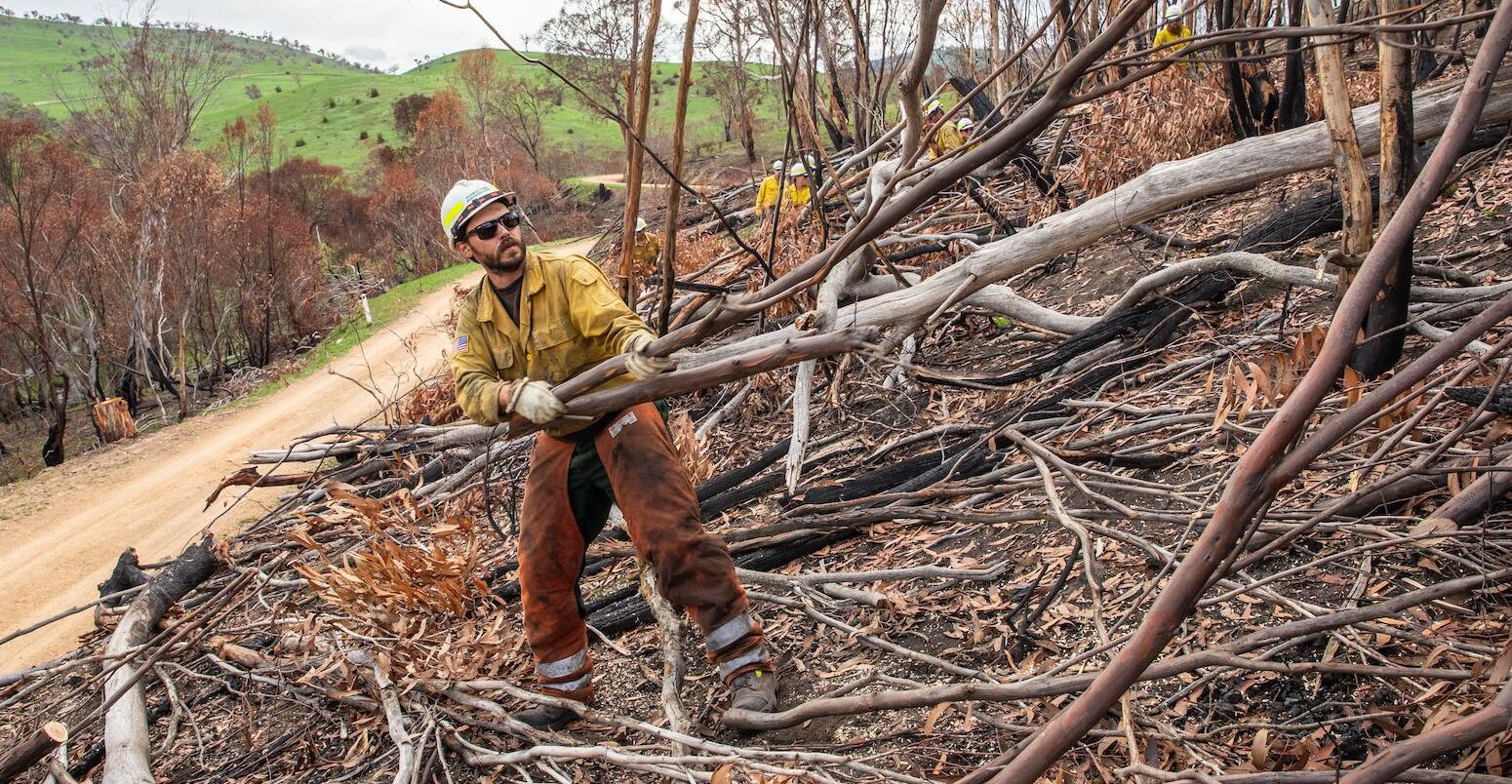
Forests taking longer to recover from severe ‘megafires’ since 2010
Orla Dwyer
05.02.25Orla Dwyer
02.05.2025 | 1:07pmForests around the world are taking longer to recover from severe wildfires – potentially indicating forest decline, according to a new study.
The research, published in Nature Ecology & Evolution, finds a “significant increase” in the severity of forest fires from 2001-10 to 2010-21 – especially in western North America, parts of Siberia and south-eastern Australia.
It also finds that recovery from large fires has become “more difficult” for forests in recent years, particularly in the boreal forests of the far-northern latitudes.
Furthermore, fewer than one-third of all forests studied recovered successfully within seven years of a “megafire” – a broad term used to refer to extreme fires.
A “surprising discovery” was that fire severity had the largest impact on forest recovery – even more than climate change, one of the study authors tells Carbon Brief.
One researcher, who was not involved in the study, notes that the findings are “expected, but not previously reported on such a large scale”.
‘Significantly increased’ severity
The area burned by forest wildfires around the world increased by about 5% annually between 2001 and 2023, according to analysis from the World Resources Institute.
Burning forests release carbon dioxide (CO2) and these emissions can continue for years after the fire has been extinguished. CO2 emissions from forest fires soared by 60% globally between 2001 and 2023, a 2024 study found.
Fire can also harm plant and animal life in a forest, although it is not always harmful for ecosystems. Forests are sometimes burned in a controlled manner to clear debris and rejuvenate soils.
But more frequent and more intense wildfires, fuelled by climate change, can destroy forests and make recovery more challenging.
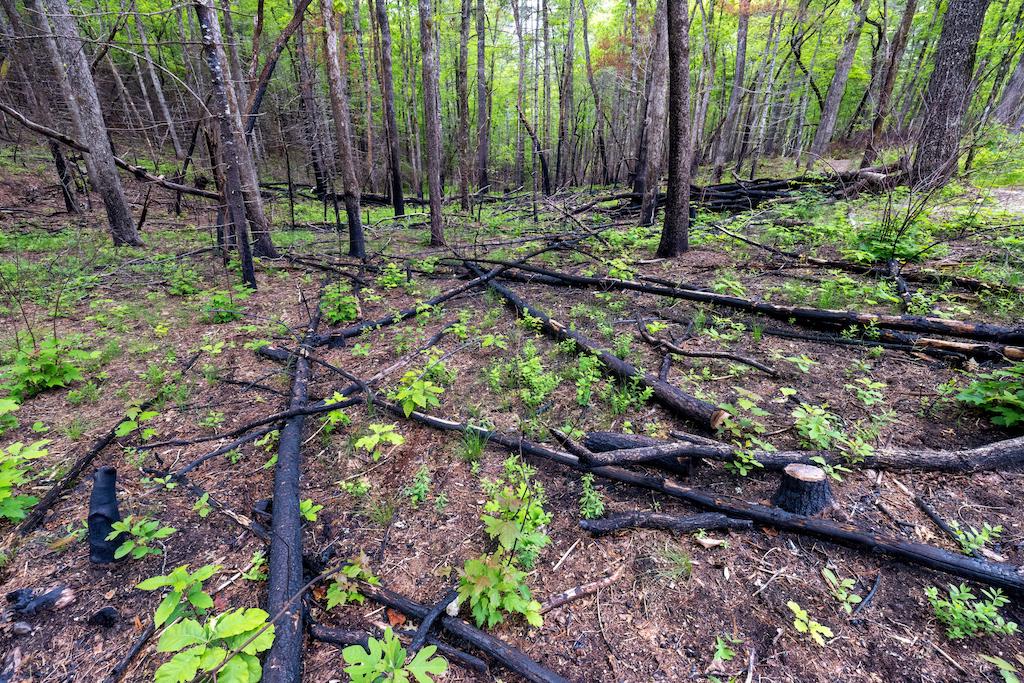
In the new study, researchers set out to assess whether intensifying fires and climate change have made post-wildfire forest recovery more difficult since 2010.
They use remote sensing data to identify 3,281 forest fires around the world larger than 10 square kilometres between 2001 and 2021. They focus on forests that were not impacted by deforestation or other fires in the seven years after a large fire took place, which the study describes as a “critical timeframe for recovery and reconstruction”.
Focusing on one-off, large fires allowed the researchers to “more accurately isolate” the drivers of the natural post-fire recovery and avoid the “confounding effects from re-burning disturbances”, Qiancheng Lv, a PhD student from Beijing Normal University, the new study’s first author, tells Carbon Brief.
They find that fire severity has “significantly increased” around the world, especially in boreal forests, since 2001, another author, Prof Ziyue Chen from Beijing Normal University, tells Carbon Brief.
This is the “primary factor” behind forests taking longer to recover from fires, the study finds. Chen adds:
“More concerningly, the adverse impacts of changing environmental conditions – especially rising temperatures and soil moisture deficits – on forest recovery are intensifying, necessitating urgent attention.”
The maps below highlight the difference in severity from large fires between 2001-10 (top) and 2011-21 (bottom). The researchers use an index called the differential normalised burn ratio (dNBR), which evaluates the level of burn damage after a fire.
They highlight five “hotspots” that frequently experience severe large-scale fires: western North America, northern South America, parts of Siberia, south Asia and south-eastern Australia.
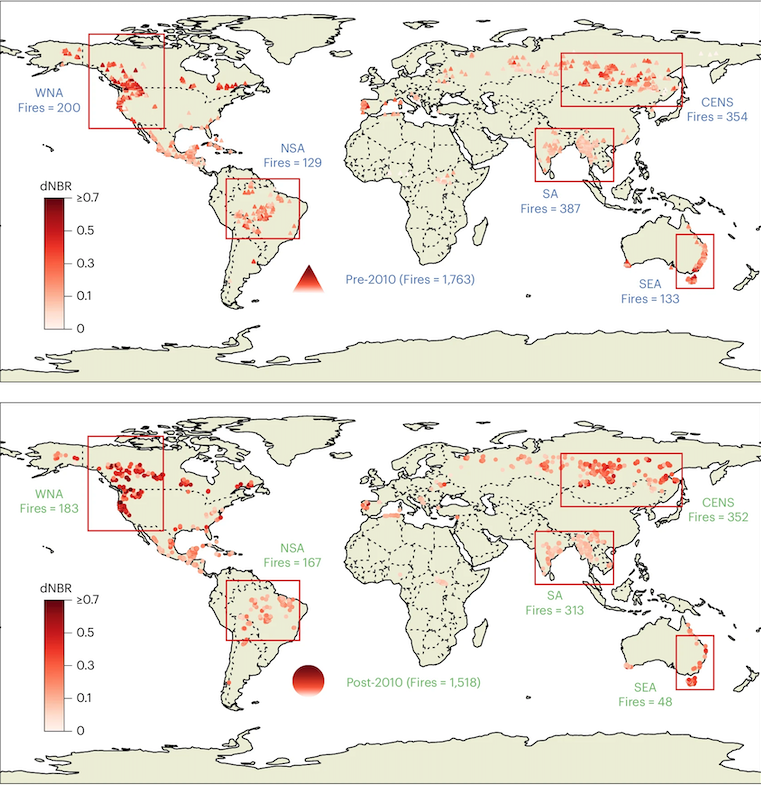
Climate role
The research finds that all forest types experienced more severe fires since 2010, but that evergreen needleleaf forests were most vulnerable to damage.
Western North America and central and eastern parts of northern Siberia experienced the more severe fires, the study finds, and also saw the largest increase in severity after 2010. “Very few” forests in these two regions successfully recovered from fires within the study period – and most are still in the process of healing, the study adds.
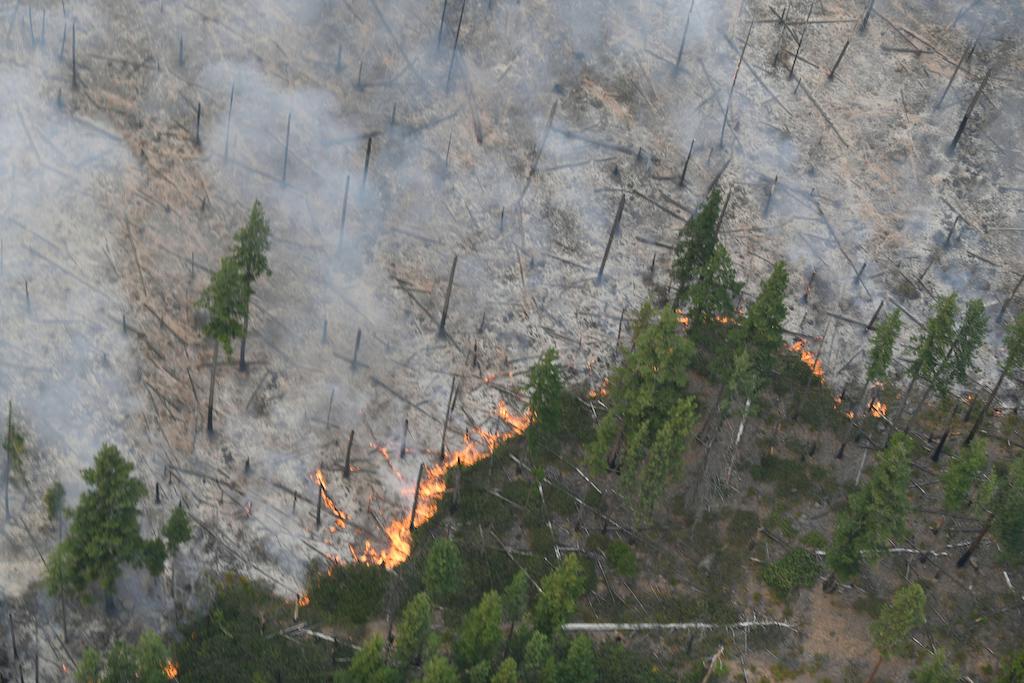
The researchers use machine-learning models to assess the impact of different factors on post-fire recovery. Fire severity primarily influences initial recovery conditions, compared to climate factors, which impact successful vegetation regrowth.
They find that fire severity “had a more significant impact on forest recovery than climate change”. This “dominant role” was the team’s “most surprising discovery”, Chen tells Carbon Brief.
But, the authors note that current climate conditions “have become increasingly unfavourable” for forest recovery from fires, particularly due to rising temperatures.
The study finds that higher temperatures “generally accelerated post-fire forest recovery” before 2010, but had “strong negative impacts” since 2010.
Prof Chaoyang Wu, another author of the study from the Chinese Academy of Sciences, tells Carbon Brief:
“While numerous studies report beneficial effects of warming on vegetation greenness and productivity, our results suggest these benefits may diminish or reverse as temperatures surpass optimal ranges for photosynthesis.”
The chart below shows the different factors impacting forest recovery times. The differential normalised burn ratio – a measure of the damage caused by a fire – has the biggest impact, followed by temperature and soil moisture.
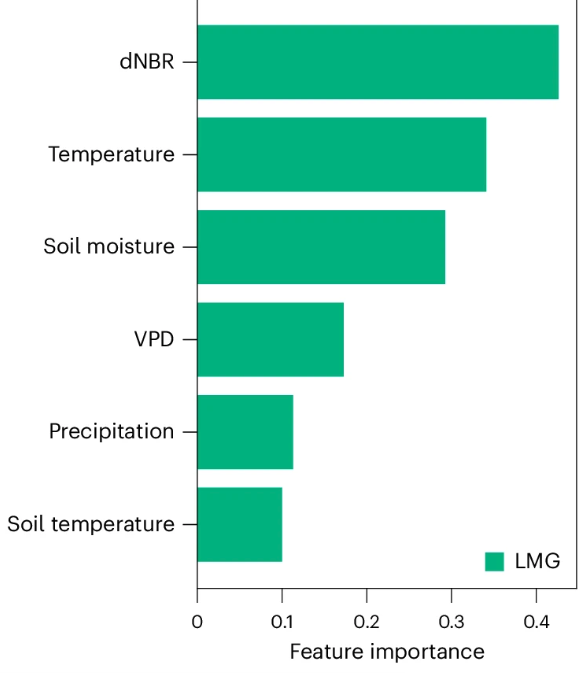
This finding contrasts with a 2024 study, which found that post-fire climate conditions had the biggest impact on forest recovery.
Accounting for this difference, Chen says that the new research focuses on “high-severity megafires”, whereas the 2024 study looks at all fire types. He adds:
“This finding highlights the critical need to account for fire scale in future post-fire recovery research, particularly as wildfire extent and intensity are projected to intensify under climate change.”
Forest recovery ‘stagnation’
The team uses multiple indices to assess three different aspects of forest recovery in the years after the fire: vegetation density, forest canopy structure and forest productivity.
The average time required for three indicators to recover to pre-fire conditions has increased by around 8% for vegetation density, 11% for canopy structure and 27% for gross primary productivity since 2010.
This results in overall recovery times that were several months to almost a year longer, compared to 2001-10 recovery times. The percentage of forests taking six years to recover from fires increased from around 11-13% before 2010 to 16-22% post-2010.
The first three years after a fire are “critical for forest recovery”, the researchers say, with many recovery assessments returning to upwards of 75% of pre-fire conditions during this time.
After this, recovery can slow down. The study finds that the percentage of forests experiencing this “stagnation” grew slightly from almost 23% before 2010 to almost 26% after 2010.
Prof Guido van der Werf from Wageningen University in the Netherlands, who was not involved in the research, tells Carbon Brief:
“It is a neat paper that quantifies something that is expected, but not previously reported on such a large scale: with increased fire activity in forests there seems to be slower recovery. This makes sense if fires are getting more severe due to climate change and, in some regions, due to having a growing fire deficit.”
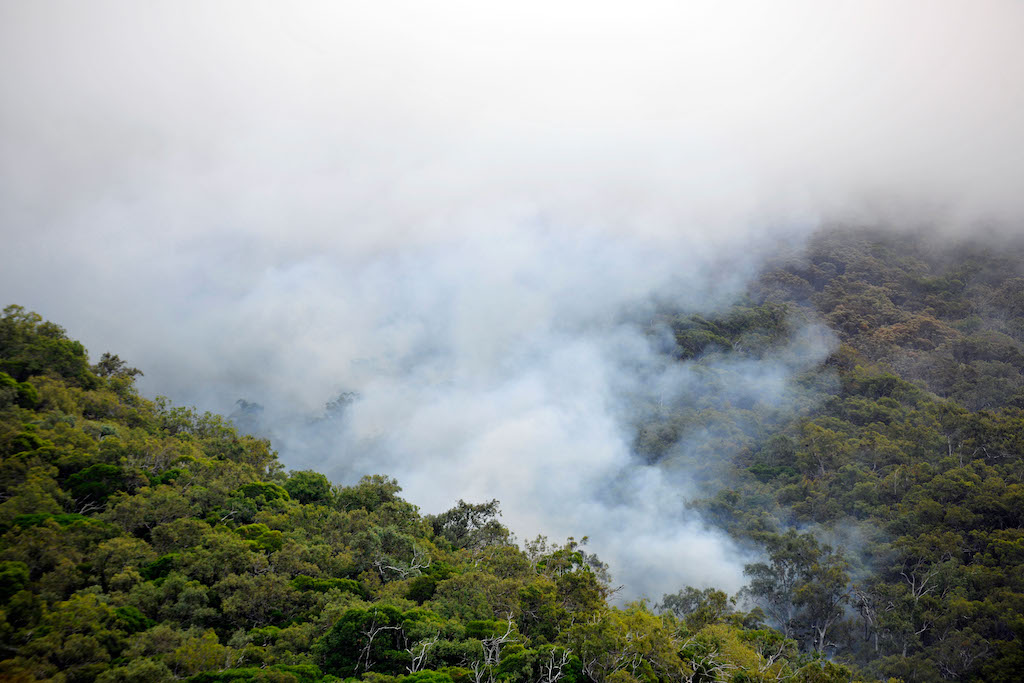
The study finds that forests in humid regions generally recovered “relatively rapidly” after fires, while those in drier regions took longer. Around 60-80% of forests that successfully recovered from fires within seven years were located in humid regions.
‘Important analysis’
Dr Bernardo Flores, a researcher at the Federal University of Santa Catarina in Brazil, says the new work is a “very important analysis” that aligns with previous research.
Flores, who was not involved in this study, has researched the impact of fires and other disturbances on the Amazon rainforest. He tells Carbon Brief that these findings are a “bad sign for the world and also for tropical forests”, adding:
“If global forest flammability is rising, this will also affect tropical forests during drier years, as we saw in 2023-24 in the Amazon.”
The researchers note that few Earth system and vegetation growth models currently account for fires – and none account for changes in forest recovery time. Van der Werf tells Carbon Brief:
“One of the implications is that forests may shift sooner from being a [carbon] sink to being a source, or smaller sink, as increased fire activity and severity and slower regrowth means that less carbon is stored in forests and more in the atmosphere.”
Lv, Q. et al. (2025) Increasing severity of large-scale fires prolongs recovery time of forests globally since 2001, Nature Ecology & Evolution, doi:10.1038/s41559-025-02683-x



